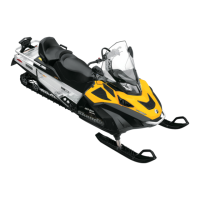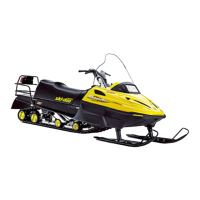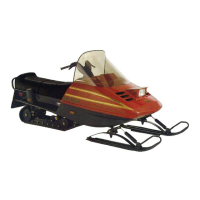RIDING THE VEHICLE
your track. Turn the engine off, free the
skis by pulling them out and downhill,
place the rear of the snowmobile uphill
restart the engine and ease it out with
slow even throttle pressure. Position
yourself to avoid tipping over, then de-
scend.
Downhill
Downhill driving requires that you have
full control of your vehicle at all times.
On steeper hills, keep your center of
gravity low and both hands on the han-
dlebar. Maintain slight throttle pres-
sure and allow the machine to run
downhill with the engine operating.
If a higher than safe speed is reached,
slow down by braking but apply the
brake with frequent light pressure.
Never jam the brake and lock the track.
Side Hill
When crossing a side hill or travers-
ing up or downhill, certain procedures
must be followed. All riders should
lean towards the slope as required for
stability. The preferred operating po-
sitions are the kneeling position, with
thekneeofthedownhilllegonthe
seat and the foot of the uphill leg on
the running board, or the posting posi-
tion. Be prepared to shift your weight
quickly as needed. Side hills and steep
slopes are not recommended for a be-
ginner or a novice snowmobiler.
Avalanche Hazard
When riding on mountainous terrain,
you should be aware of the risk of
avalanches. Avalanches vary in size
and shapes and generally occur in
steep terrain and on unstable snow.
New snow, animals, people, wind
and snowmobiles can all trigger
an avalanche. Avoid high marking
or traversing steep terrain when
avalanche conditions are pos
sible.
When in unstable snow conditions,
travel should be restricted to lower
angle slopes. Wind formed c
ornices
should be avoided. Staying off un-
stable conditions is the key to safe
mountain riding. Probably most impor-
tant is to be aware of the conditions
and dangers on a daily basis when in
the mountains. Check local avalanche
forecasts and threats each day before
heading out to ride and heed forecast-
ers advice.
Youshouldalways carryasnow shovel,
probe and avalanche beacon while rid-
ing on mountains. We recommend
that all mountain riders take a lo-
cal avalanche safety training course
to become more familiar with snow
conditions and learn how to properly
use their equipment.
Here are some web sites that can help
you finding important information:
–US:www.avalanche.org
– Europe: www.avalanches.org
– Canada: www.avalanche.ca
Slush
Slush should be avoided at all times.
Always check for slush before starting
across any lake or river. If dark spots
appearinyourtracks,getofftheice
immediately. Ice and water can be
thrown rearward into the path of a fol-
lowing snowmobile. Getting a vehicle
out of a slush area is strenuous and in
some cases, impossible.
Fog or Whiteout Conditions
On land or water, fog or visibil-
ity-limiting snow can form. If you have
to proceed into the fog or heavy snow,
do so slowly with your lights on and
watch intently for hazards. If you are
not sure of your way, do not proceed.
Keep a safe distance behind other
snowmobilers to improve visibility and
reaction time.
Unfamiliar Territory
Whenever you enter an area that i
s
new to you, drive with extreme cau-
tion. Go slow enough to recognize
potential hazards such as fen
ces or
fence posts, brooks crossing your
16
_______
SAFETY I
NFORMATION
________

